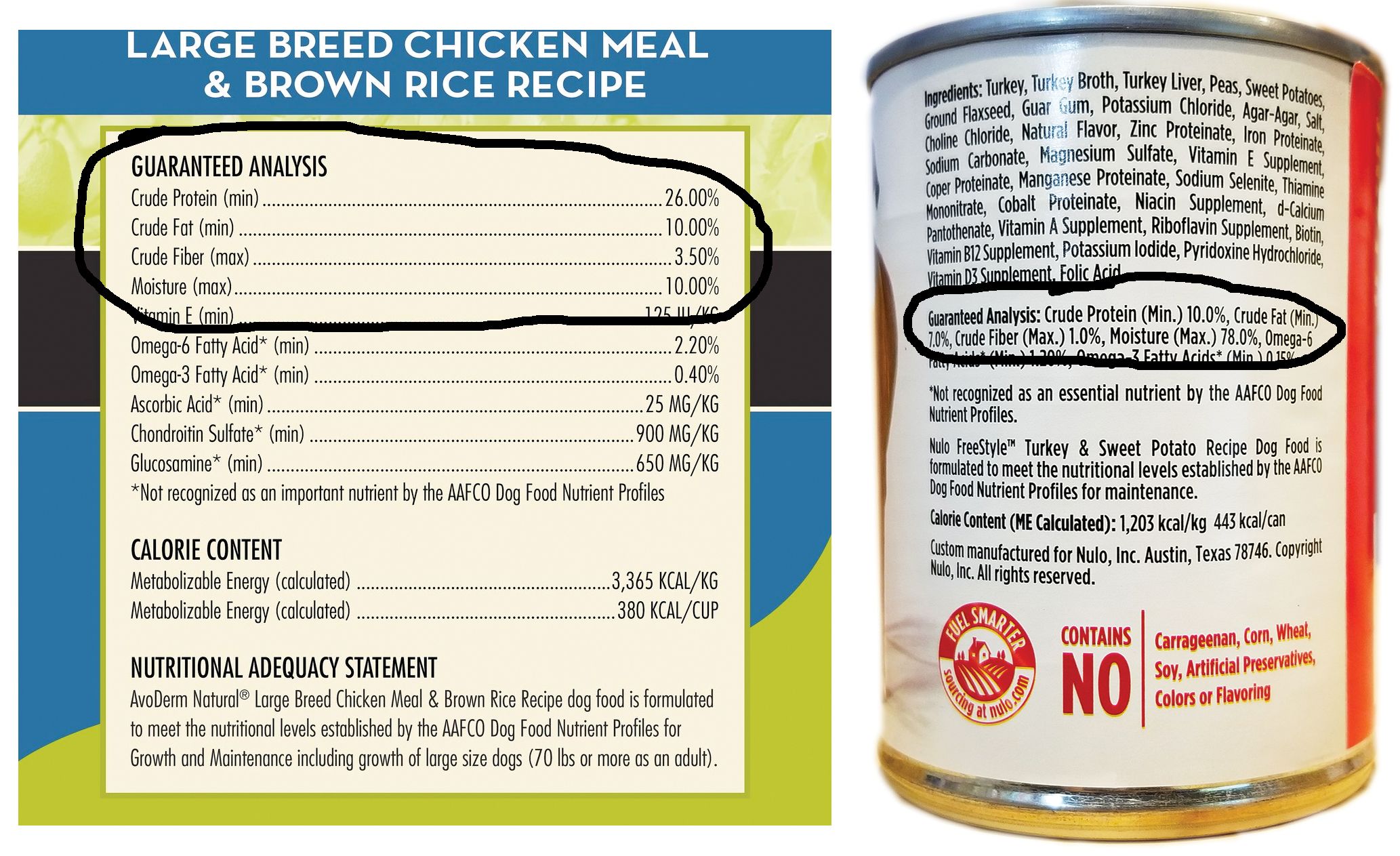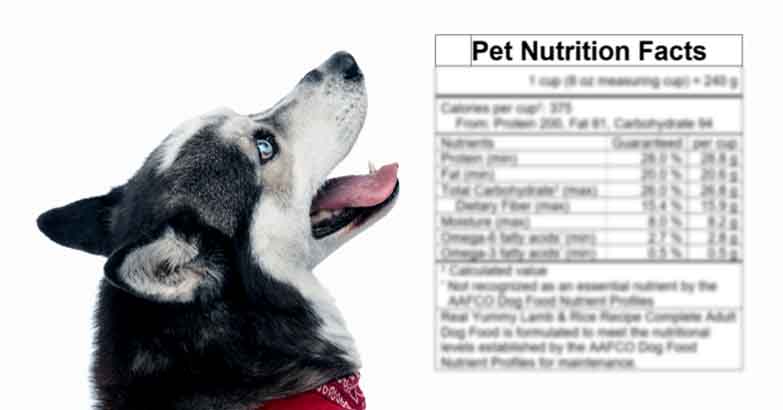Dog food nutrition labels provide essential information about the ingredients and nutritional content of the product, including the percentage of crude protein, crude fat, crude fiber, and moisture. Understanding these labels is crucial for ensuring that your dog's dietary needs are met.
When selecting a dog food, it's important to carefully read and interpret the information on the label to make an informed decision that supports your pet's health and well-being. By examining the guaranteed analysis, ingredient list, and nutritional adequacy statement, you can determine whether the food meets your dog's specific nutritional requirements.
Additionally, being familiar with the regulations and standards for pet food labeling can help you navigate the array of options available and choose the best diet for your furry companion.

Credit: www.whole-dog-journal.com
Decoding Dog Food Labels
Dog food labels provide essential information on nutrient content and quality standards.
Required details include crude protein, fat, fiber percentages, and ingredient listings.
Manufacturers must adhere to regulations set by AAFCO for accurate labeling.
Understanding these labels ensures your dog receives proper nutrition and diet.

Credit: www.dogsnaturallymagazine.com
Guaranteed Analysis Explained
Many states have regulations requiring the minimum amount of nutrients a pet food must contain, as well as the maximum amount of moisture and crude fiber. Dog food labels must display the percentage of crude protein, crude fat, crude fiber, and water.
State regulations require minimum nutrients and maximum moisture and crude fiber. The labels must show percentages of protein, fat, fiber, and water.
Labels must display the percentage of moisture and crude fiber.
Ingredient List Insights
| Blog post title: | Dog Food Nutrition Labels |
| Heading: | Ingredient List Insights |
| Subheading: | Order of Ingredients |
When reading dog food nutrition labels, it's important to pay attention to the order of ingredients listed. The order indicates the quantity of each ingredient in the product. The first ingredient listed is the most abundant, while the last ingredient is the least abundant.
Identifying quality components is crucial. Look for whole food ingredients, such as real meat, vegetables, and grains, as the primary ingredients. Avoid products that list fillers, by-products, or artificial additives at the top of the ingredient list.
Understanding the order of ingredients can help you make informed choices about the nutritional quality of dog food. By selecting products with high-quality ingredients listed at the beginning of the list, you can ensure your dog gets the necessary nutrients for optimal health.
Nutritional Adequacy Statement
Dog food nutrition labels provide important information about the nutritional content of the food and help pet owners make informed decisions about what to feed their dogs. One crucial aspect of these labels is the Nutritional Adequacy Statement, which indicates whether the food meets the minimum nutrient requirements established by regulatory bodies.
Understanding Nutrient Profiles is another important subheading under the Nutritional Adequacy Statement. This section helps pet owners determine whether the food is suitable for their dog's life stage, such as puppy, adult, or senior. It provides information on the specific nutrient requirements dogs need at different stages of their lives.
Matching food to your dog's life stage is essential for their overall health and well-being. By reading and understanding dog food nutrition labels, pet owners can ensure that their furry friends are receiving the necessary nutrients to thrive.
Feeding Guidelines On Packages
Dog food nutrition labels provide important information for pet owners to ensure their dogs receive the right nutrients. Feeding guidelines on packages offer portion sizes and frequency recommendations. These guidelines may need adjustments for different activity levels. It's crucial for pet owners to understand how to read labels to make informed decisions about their dog's diet.
Manufacturer Information
Manufacturer information on dog food nutrition labels should include the company's name, address, and ideally a contact number for easy communication. This crucial detail helps pet owners make informed decisions about their furry friends' dietary needs.
| Manufacturer Information |
| Contact Details and Accountability |
When researching dog food nutrition labels, it's crucial to look for the manufacturer's information. This includes contact details and accountability.
The label should display the manufacturer's name, address, and ideally a phone number for easy communication. This information ensures transparency and helps consumers make informed choices about their pet's nutrition.
Caloric Content Per Serving
When looking at dog food nutrition labels, it's important to pay attention to the caloric content per serving. Calculating your dog's energy needs is crucial for weight management and ensuring they are getting the proper amount of calories.
Many states have regulations requiring the minimum amount of nutrients a pet food must contain, as well as the maximum amount of moisture and crude fiber. Dog food labels must display the percentage of crude protein, crude fat, crude fiber, and water. It's also important to read the ingredient list and nutritional adequacy statement to ensure the food meets your dog's nutritional needs.
The Role Of Aafco
When it comes to understanding dog food nutrition labels, it's important to know the role of AAFCO. AAFCO stands for the Association of American Feed Control Officials, and they set industry standards for pet food.
These standards include regulations for the minimum amount of nutrients a pet food must contain, as well as the maximum amount of moisture and crude fiber. On dog food labels, you'll see the percentage of crude protein, crude fat, crude fiber, and water displayed. It's important to read and understand these labels to ensure your pet is receiving the proper nutrition they need.
AAFCO also approves new label regulations for pet food. Legally, pet food labeling is regulated at two levels, with current FDA regulations requiring proper identification of the product, net quantity statement, name and place of business of the manufacturer or distributor, and proper listing of all the ingredients in the product from most to least, based on weight.
Reading and deciphering dog food labels can be a daunting task, but it's essential for your pet's health and well-being. Make sure to understand what the labels mean and what nutrients your pet needs to thrive.
Frequently Asked Questions
What Should Be On A Nutritional Label For Dog Food?
A nutritional label for dog food should include guaranteed analysis for crude protein, fat, fiber, and water content. It must also list the manufacturer's information and ingredient list. This ensures you can easily assess the food's nutritional value and make informed choices for your dog.
What Are The Nutritional Standards For Dog Food?
The nutritional standards for dog food include displaying the percentage of crude protein, crude fat, crude fiber, and water on the label. Additionally, many states have regulations for the minimum amount of nutrients and maximum moisture and crude fiber. The label should also provide the product name, weight or volume, ingredient list, and nutritional adequacy statement.
It is important to read and understand these labels to ensure your dog's nutritional needs are met.
What Is The 25% Rule In Dog Food?
The 25% rule in dog food refers to the guaranteed analysis on the nutritional label. It states that the percentage of crude protein, crude fat, crude fiber, and water must be listed on the label. This helps dog owners understand the nutritional content of the food and make informed decisions for their pets.
What Is Legally Required On A Pet Food Label?
Pet food labels must include the product name, net quantity, manufacturer's name and address, ingredient list, and guaranteed analysis of crude protein, fat, fiber, and moisture.
How To Interpret Dog Food Labels?
Dog food labels show key nutritional information like protein, fat, fiber, and water percentages.
Conclusion
Understanding dog food nutrition labels is crucial to ensure that your furry friend is getting the right nutrients they need to live a healthy life. The labels must include information on the minimum and maximum amounts of key nutrients, such as protein, fat, fiber, and moisture, and must meet state and federal regulations.
It's important to read the labels carefully and choose a food that meets your dog's specific nutritional needs. By following these guidelines and paying attention to the labels, you can make informed decisions about your dog's diet and help them live their best life.











